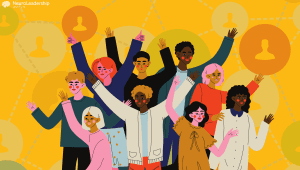
Here’s How To Make Diversity Training Better
Diversity training can feel performative, and elicit groans from those asked to attend. But it absolutely can be impactful, and that’s through a mix of both delivery and measurement.
Thank you for searching the NeuroLeadership Institute archives. Here’s what we were able to find for you.
Still having difficulty finding what you’re looking for? Contact us.

Diversity training can feel performative, and elicit groans from those asked to attend. But it absolutely can be impactful, and that’s through a mix of both delivery and measurement.

With tensions, anxiety, and burnout on the rise, de-escalation has rapidly become an essential skill for managers in the workplace.

Psychological research can help us better direct diverse teams to the right places, and at the right time, to make the most of early wins.

Celebrating differences in teams may sound well-intentioned, but research shows it pays to build inclusion through celebrating similarities.

Inclusion is proven to be good for business, but it’s also been shown to afford employees a host of psychological and physical benefits.

This crisis’ effects are physical and psychological. Here are the everyday psychological habits to keep your mind healthy and stay productive.

Face to face with a crisis, it’s seldom clear where to focus our attention. NLI has assembled frequently asked questions about what leaders should do.

While many people have started going back into the office, talent leaders should stay mindful of those still at home—and how to cater to both groups.

With employees working longer hours than usual, leaders may wonder if they should move to a four-day workweek. Here’s what brain science says.

Social interaction significantly contributes to mental health—taking it away jeopardizes our stability. To stay connected, we to need bring back the personal.

Learn the essential habits for leading inclusive virtual meetings and keep your team engaged, collaborative, and innovative in the process.

With many employees working from home full-time, developing these five habits to mitigate distance bias is critical to good decision-making.

Working remotely may be the new normal for the foreseeable future. Learn how you can make working remotely more brain-friendly, productive, and inclusive.

We can learn a lot from the failed speaking-up moments from ill-fated flights like the Challenger. Learn how to help your team speak up when it matters.

Range is critical for not only individuals, but teams too. Learn how cultivating collective range can help your team defeat groupthink.

The culmination of the NFL season gives us a good opportunity to think about what great coaches can teach us about great leadership.

Author and speaker Douglas Rushkoff will give the opening keynote address at this year’s NeuroLeadership Summit, speaking on why we should keep teams human.
Jam-packed meetings and overflowing project teams don’t do anyone any favors. They cause delays, create confusion, and generally make organizations less effective. At the NeuroLeadership Institute, we view this as a product of over-inclusion — not in the strategic sense, like for hiring, but for more tactical matters. It’s what happens when well-meaning leaders involve more people than necessary to avoid certain people feeling left out. But what leaders really need, according to the brain science, is to learn the tactical habit of “thoughtful exclusion.” We recently explored the concept of thoughtful exclusion for HBR, in a piece titled “How to Gracefully Exclude Coworkers from Meetings, Emails, and Projects.” It makes three basic prescriptions, which we’ve summarized below. Manage cognitive overload Research has found that 3% to 5% of employees at a given organization drive the bulk of collaboration. In turn, they also tend to be the most prone to burnout. Leaders can begin practicing thoughtful exclusion by identifying these employees, and then strategically limiting their involvement in projects and meetings. The technique affirms to people that their input is valued, but also makes clear that not every project deserves the same level of attention. Consider the social brain Humans seek out potential threats and rewards at nearly all times, even in social situations. This means the act of excluding others is intensely emotional (as those who have been left out know firsthand). Specifically, people may feel a threat to their relatedness, or the sense that they belong in a certain group. With the right language, leaders can actively minimize employees’ threat response. For instance, instead of casually mentioning to someone that they are no longer needed on a project, leaders can provide the surrounding context and reasoning for the decision. They can say things like, “I know you’ve already got a lot on your plate, and I’d like to keep you off this meeting so you can stay focused. What do you think?” This is the “thoughtful” component of thoughtful exclusion. It communicates a leader has an awareness of others, and when employees sense that awareness, they don’t feel as threatened. Set the right expectations Addressing people’s social needs is partly a matter of addressing their cognitive needs. The science has made it clear that there’s a great cost to defying a person’s expectations. When our brains think one thing will happen, but then something else happens, the brain uses much more energy to process that new information. Leaders can use this insight to better communicate about particular projects. They can give people strong rewards of certainty and fairness — two other domains of social reward or threat — by being transparent about their decision-making. Each person who enters the meeting will know why they, and everyone else, is there. And everyone who doesn’t get invited will know why, too. When leaders harness the science to get their teams on the same page, they can avoid the pains of politeness and assemble the right talent for each project. As a result, organizations as a whole can start doing more with less.

Business leaders can learn a lot about diversity from college kids solving fake murders. It was 2009. Northwestern University researchers had just given groups of fraternity and sorority members mock murder cases to solve. Suddenly, each group learned they were getting a new member. Half of the groups welcomed someone from within their frat or sorority, an “insider”; the other half got a rival member, an “outsider.” When the researchers tallied the results, they found the teams that solved the most murders were those with rival members, not people with whom participants already identified. As in, teams with members from rival frats and sororities outperformed those that were all from the same group. Remarkably, this was despite team members in the diverse condition feeling less positive about their interactions, and less confident in their final conclusion, than the homogenous group. Why diverse teams are smarter The business wisdom we can glean from this study is profound, and it holds great importance as teamwork and collaboration become more essential to working life. Let’s call it the “diversity paradox.” It states that diverse teams often make smarter decisions than non-diverse teams, but — crucially — at the expense of having confidence in that decision. The smartest teams embrace this paradox, putting faith in diversity-driven outputs above comfort in consensus. Diverse teams are smarter teams because they rid the air of groupthink, a term coined in 1971 to describe the possible psychological mechanisms that led to the Bay of Pigs Invasion 10 years prior, an event widely seen as a failure of decision-making. Groupthink, in other words, is what causes groups of “smart” people to go along with “dumb” choices. As NLI recently presented in “How Diversity Defeats Groupthink,” having a mixture of backgrounds and experiences is critical for organizations to avoid groupthink. And the 2009 Northwestern study puts an even finer point on the matter. It suggests that leaders must set the right expectations — for themselves and their team members — for how interactions will feel, in order for people to stay motivated when things get tough. Trust the process, not the feeling When teams are more diverse, instead of feeling fluent or smooth, they will often feel disjointed and even a little tense. That’s because diverse teams don’t (and can’t) settle into familiar ways of thinking; people’s ideas and assumptions are inherently at odds, even if in small doses. Every decision requires thought and effort, a collection of point-counterpoint moments until what emerges is a fuller, more bulletproof idea. However, as we’ve found in our research and work with clients, that friction is essential for arriving at the best solutions. When people feel overly comfortable with one another, they may defer to hierarchy, make dangerous assumptions, use illogical thinking, or succumb to pressures of group conformity. Outsiders, meanwhile, shake things up. They put people on their toes and raise everyone’s level of sensitivity, reducing the chances of what Princeton economist Roland Benabou calls “acting colorblind in a sea of red flags.” Decision-making may never be perfect — so long as teams are composed of bias-laden and error-prone humans — but embracing the discomfort of diversity yields far greater rewards than playing it safe ever will.
Join millions of employees in creating culture change at scale by reaching out today.

In 2007, David and Lisa Rock and their team had been working in leadership development and executive coaching for ten years, when David coined the term “NeuroLeadership.”ef

North America
Africa
South America
Asia
Europe
Australia
© NeuroLeadership Institute 2025. All Rights Reserved
This site uses cookies to provide you with a personalized browsing experience. By using this site you agree to our use of cookies as explained in our Privacy Policy. Please read our Privacy Policy for more information.